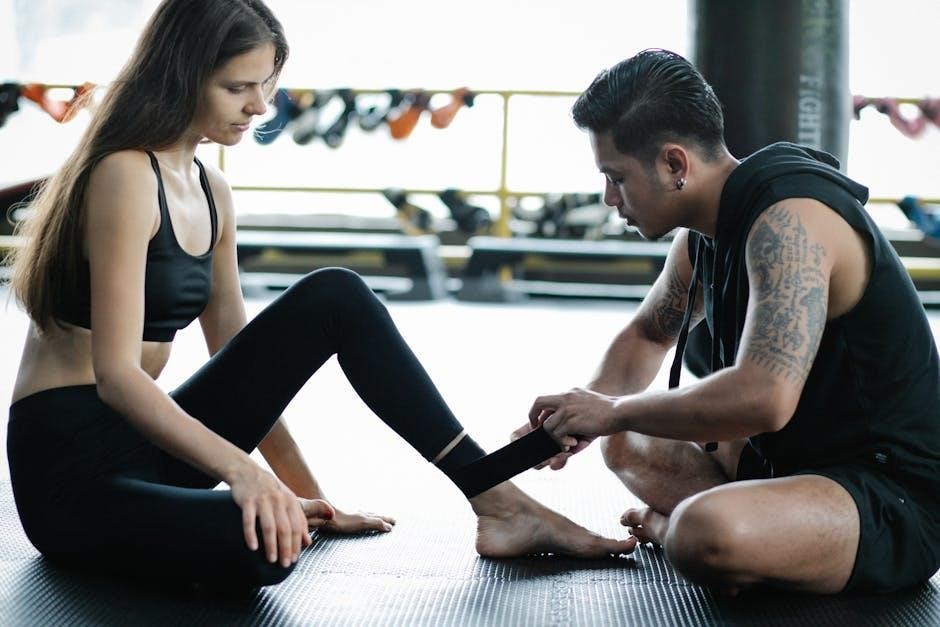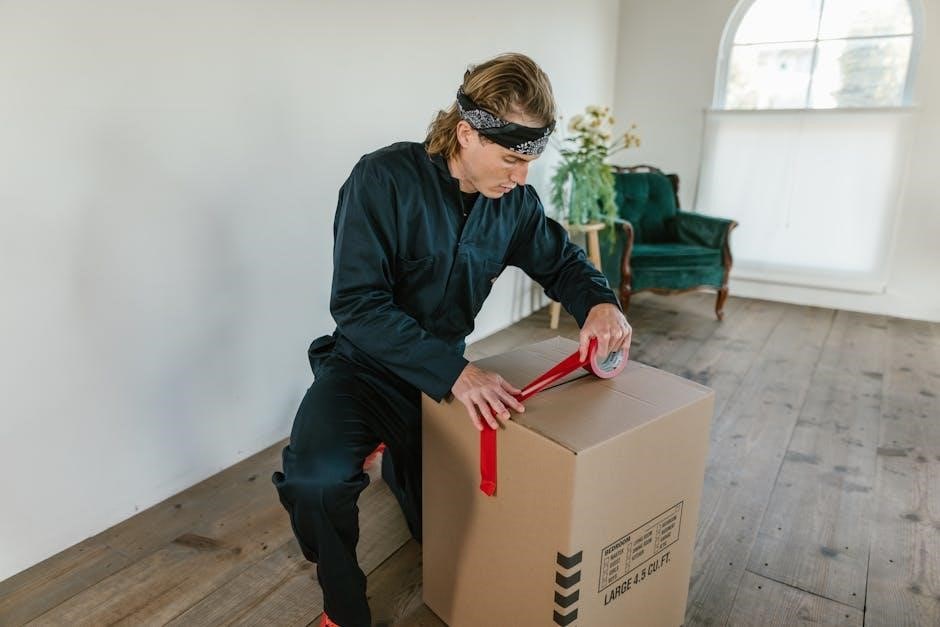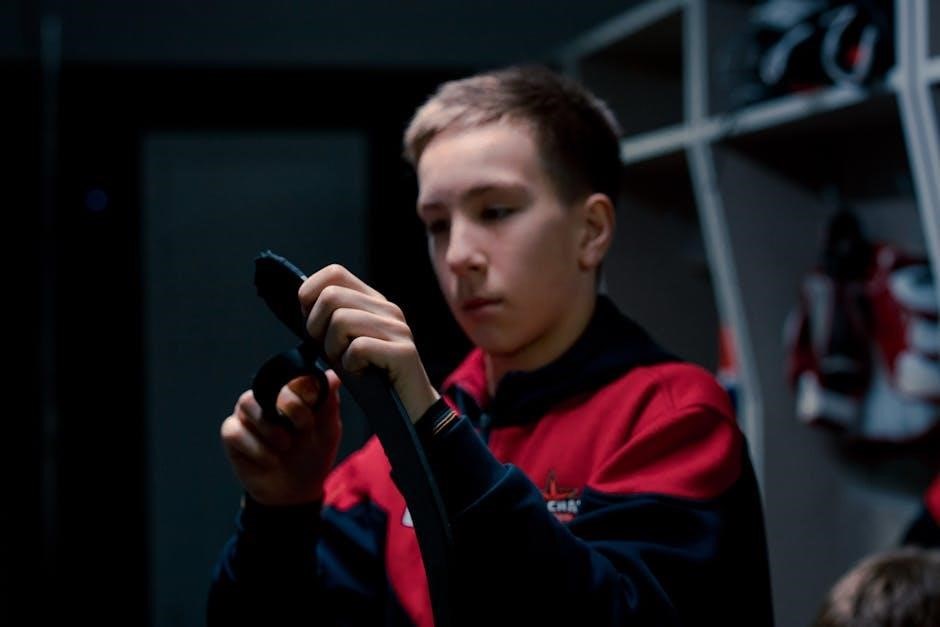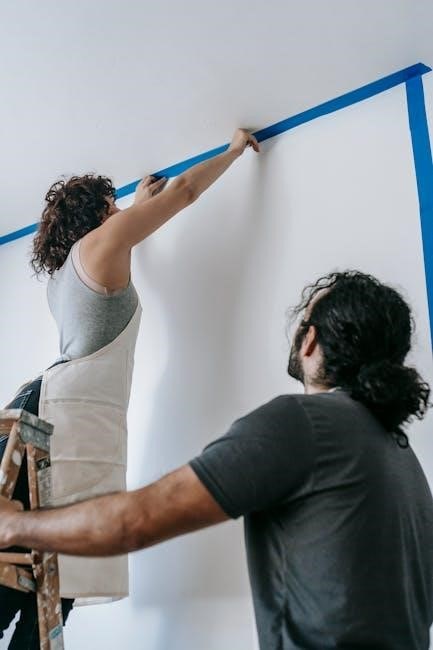Plantar fasciitis is inflammation of the plantar fascia, causing heel pain. Taping techniques, like Low-Dye and KT Tape, provide support and reduce stress on the fascia.
1.1. What is Plantar Fasciitis?
Plantar fasciitis is an inflammatory condition affecting the plantar fascia, a thick band of connective tissue running along the bottom of the foot. It is the most common cause of inferior heel pain and can occur at any age, though it is prevalent in middle-aged women and younger male runners. Symptoms often include sharp pain near the heel, especially with the first steps of the day. The condition arises from overuse, poor footwear, or abnormal foot mechanics, such as overpronation. If left untreated, plantar fasciitis can lead to chronic pain, disrupting daily activities and athletic performance. Early intervention is crucial for effective management and recovery.
1.2. The Role of Taping in Managing Plantar Fasciitis
Taping plays a significant role in managing plantar fasciitis by providing immediate support and reducing stress on the plantar fascia. Techniques like Low-Dye and kinesiology taping are commonly used to offload the fascia, alleviate pain, and improve mobility. Taping helps in redistributing pressure, thereby minimizing discomfort during activities. It is particularly beneficial for athletes and individuals with overpronation, offering a non-invasive and cost-effective solution. By stabilizing the foot and ankle, taping can also prevent further inflammation and promote healing. This method is often recommended as part of a comprehensive treatment plan, alongside other therapies, to enhance recovery and restore normal foot function effectively.
1.3. Benefits of Using Taping Techniques

Taping techniques offer numerous benefits for managing plantar fasciitis. They provide immediate pain relief by reducing stress on the plantar fascia. Taping enhances foot stability, improving gait and reducing discomfort during daily activities. It is a non-invasive and cost-effective method, making it accessible for home use. Taping also allows for continued mobility, enabling patients to maintain their active lifestyle. Additionally, it can be combined with other treatments like physical therapy for better outcomes. The simplicity and effectiveness of taping make it a valuable first-line treatment option for individuals seeking quick relief from plantar fasciitis symptoms, promoting faster recovery and overall foot health.
Common Taping Techniques for Plantar Fasciitis
Common taping techniques include Low-Dye, Kinesiology (KT Tape), and Windlass taping. These methods provide support, reduce fascia strain, and alleviate pain, catering to various patient needs effectively.
2.1. Low-Dye Taping
Low-Dye taping is a widely used technique to off-load the plantar fascia, reducing strain and pain. It involves applying tape around the foot and heel to provide support. This method is particularly effective for short-term relief and can be left on for up to three days. However, some patients may need more frequent replacements. Low-Dye taping is known to vary in effectiveness among individuals but is often recommended as a first-line conservative treatment. It is simple to apply and can be done at home or in a clinical setting, making it a popular choice for managing plantar fasciitis symptoms.

2.2. Kinesiology Taping (KT Tape)
Kinesiology Taping (KT Tape) is a stretchy tape applied along the bottom of the foot to support the arch and reduce plantar fasciitis pain. It works by providing gentle traction, which helps reduce stress on the plantar fascia. KT Tape is easy to apply and can be used for both short-term and long-term management. Studies, such as Tsai et al. (2010), found that continuous use for one week provided significant pain relief. This method is particularly popular among athletes and individuals with chronic heel pain, as it allows for movement while offering support. KT Tape is also easy to apply at home, making it a convenient option for managing symptoms effectively.

2.3. Windlass Taping
Windlass taping is a technique designed to reduce pain in plantar fasciitis by applying tape to the forefoot and toes. This method works by creating a gentle flexion of the toes, which shortens the plantar fascia and reduces tension. The tape is typically applied in a circular or crisscross pattern around the forefoot, with additional strips connecting the toes to the heel. The goal is to off-load the plantar fascia during walking or running. Studies suggest that Windlass taping can provide immediate relief for some patients, particularly during the acute phase of the condition. It is often used in combination with other treatments for optimal results.
2.4. Comparison of Different Taping Techniques
Various taping techniques, such as Low-Dye, Kinesiology Taping (KT Tape), and Windlass taping, are used to manage plantar fasciitis. Low-Dye taping focuses on off-loading the plantar fascia by redistributing stress, while KT Tape provides elastic support to reduce pain and inflammation. Windlass taping targets the forefoot to shorten the plantar fascia and alleviate tension. Studies suggest that Low-Dye and Windlass taping are more effective for immediate pain relief, whereas KT Tape offers longer-term support. Each technique has its unique benefits, and the choice depends on individual needs and symptoms. Combining taping with other therapies often enhances outcomes, making it a versatile and effective treatment option for plantar fasciitis.

How to Apply Taping for Plantar Fasciitis
Proper taping involves cleaning the skin, avoiding wrinkles, and applying tape from the heel to the ball of the foot for optimal support and pain relief.
3.1. Step-by-Step Guide to Low-Dye Taping
Low-Dye taping is a widely used method to alleviate plantar fasciitis symptoms. Begin by cleaning and drying the foot. Apply a small anchor strip on the heel, then wrap the tape around the arch, starting from the heel and moving toward the ball of the foot. Ensure the tape is smooth and free of wrinkles. Secure the ends firmly but not too tightly. This technique helps offload the plantar fascia, reducing strain and pain. Leave the tape on for up to 3 days for optimal results. Proper application ensures comfort and effectiveness in managing plantar fasciitis symptoms.
3.2. Application of Kinesiology Tape
Kinesiology tape (KT Tape) is applied to support the arch and reduce plantar fascia strain. Begin by cleaning the skin and applying a base strip under the heel. Place another strip along the arch, starting from the heel and extending toward the toes; Ensure the tape is smooth and free of wrinkles. Apply gentle pressure to secure the edges. The tape can be worn for up to 5 days, providing continuous support and pain relief. Proper application ensures optimal adhesion and effectiveness in managing plantar fasciitis symptoms. This method is particularly beneficial for athletes and individuals with chronic heel pain, offering both support and flexibility during daily activities.
3.3. Tips for Proper Tape Adhesion
Ensuring proper tape adhesion is crucial for effective plantar fasciitis management. Clean and dry the skin thoroughly before application to remove oils or lotions. Shave any excessive hair to prevent irritation and improve adhesion. Apply the tape without stretching to avoid skin irritation. Press firmly along the edges to secure the tape. Avoid wrapping too tightly, as this may restrict movement or cause discomfort. For sensitive skin, hypoallergenic tapes are recommended. Replace the tape if it loosens or causes discomfort. Proper adhesion enhances the tape’s effectiveness in reducing pain and supporting the plantar fascia, ensuring optimal therapeutic benefits throughout the day.
3.4. How Long to Leave the Tape On
The duration for leaving tape on varies based on factors like activity level and skin sensitivity. Generally, tape can stay on for 3 to 5 days, but some may need replacement sooner. For athletes or highly active individuals, replacing the tape daily is recommended. Remove and reapply if the tape loosens or causes discomfort. Proper adhesion is key for effectiveness, so avoid leaving it on longer than necessary to prevent skin irritation. Regular monitoring ensures the tape remains effective in supporting the plantar fascia and alleviating pain without causing adverse reactions.

Scientific Evidence and Studies
Studies show taping techniques like Low-Dye and KT Tape reduce plantar fasciitis pain and thickness, offering short-term relief and supporting foot biomechanics effectively.
4.1. Effectiveness of Taping in Reducing Pain
Multiple studies demonstrate that taping significantly reduces pain associated with plantar fasciitis. Low-Dye and KT Tape techniques have shown efficacy in alleviating heel pain and improving function. Research by Tsai et al. (2010) found that continuous use of Kinesio Tape for one week provided substantial pain relief compared to physical therapy alone. Similarly, Low-Dye taping has been shown to off-load the plantar fascia, reducing discomfort during daily activities. These methods work by providing mechanical support and reducing stress on the fascia. Patients often report immediate relief, making taping a practical and non-invasive option for managing symptoms. The evidence supports taping as an effective short-term solution for pain reduction in plantar fasciitis.
4.2; Case Studies on Taping for Plantar Fasciitis
Case studies highlight the practical benefits of taping for plantar fasciitis. A trial involving 51 patients reported a 32mm reduction in pain on a 100mm VAS scale using Low-Dye taping. Another study demonstrated that KT Tape applied lengthwise across the foot’s bottom reduced pain and supported the arch. Windlass taping, mentioned by Beth Jamali and colleagues, showed promise in pain reduction. These real-world applications provide evidence of taping’s effectiveness in managing symptoms. Such studies emphasize taping as a viable, non-invasive treatment option, offering both immediate and sustained relief for patients with plantar fasciitis, particularly when combined with other therapies like physical exercises or orthotics.
4.3. Short-Term vs. Long-Term Benefits
Taping for plantar fasciitis offers both short-term and long-term benefits. In the short term, taping techniques like Low-Dye and KT Tape provide immediate pain relief by off-loading the plantar fascia and reducing stress. Studies show significant pain reduction within the first week of application, with some patients experiencing sustained relief for several days. However, for long-term benefits, taping is most effective when combined with other treatments, such as physical therapy or orthotics. While taping alone may not resolve chronic cases, it plays a crucial role in managing symptoms and supporting recovery. Regular reapplication and adherence to proper techniques ensure consistent relief, making taping a valuable component of a comprehensive treatment plan for plantar fasciitis.
4.4. Comparison with Other Treatment Methods
Taping for plantar fasciitis is often compared to other treatment methods like orthotics, physical therapy, and corticosteroid injections. Studies suggest that taping, particularly Low-Dye and KT Tape, can be as effective as orthotics in reducing pain and improving function. Unlike corticosteroids, taping is non-invasive and carries fewer risks of side effects. While physical therapy provides long-term benefits, taping offers immediate relief and can be used as an adjunct therapy. Research indicates that taping is most beneficial in the short term for acute pain, but it may not address chronic issues alone. Combining taping with other methods often yields the best results, making it a versatile and cost-effective option for managing plantar fasciitis symptoms.

Taping for Specific Conditions and Populations
Taping is beneficial for runners, athletes, and individuals with overpronation or chronic heel pain, providing targeted support and pain relief for specific foot conditions.
5.1. Taping for Runners and Athletes
Runners and athletes often suffer from plantar fasciitis due to repetitive stress and high-impact activities. Taping techniques, such as Kinesiology Taping (KT Tape), provide arch support and reduce fascia strain. This method is particularly effective for individuals who engage in sports involving toe running, as it helps alleviate pain during training and competition. The tape can be applied lengthwise across the bottom of the foot to offer stability and minimize discomfort. Many athletes find taping to be a practical, non-invasive solution that allows them to continue their activities while managing symptoms. It is often applied before runs or events and can be combined with stretching exercises for enhanced relief.
5.2. Taping for Individuals with Overpronation
Individuals with overpronation often experience plantar fasciitis due to increased stress on the arch and heel. Taping techniques can help reduce this strain by providing additional support. Low-Dye taping is commonly used to off-load the plantar fascia, while Kinesiology Taping can help correct abnormal pronation patterns. These methods stabilize the foot, preventing excessive inward rolling during walking or running. Taping can also reduce the risk of further injury by compensating for biomechanical imbalances. For those with overpronation, combining taping with orthotics or proper footwear may offer optimal relief and long-term management of plantar fasciitis symptoms.
5.3. Taping for Middle-Aged Women and Young Male Runners
Middle-aged women and young male runners are prone to plantar fasciitis due to repetitive stress on the plantar fascia. Taping techniques, such as Low-Dye and Kinesiology Taping, are effective in reducing pain and providing support. These methods help stabilize the foot, alleviating stress during running or walking. For runners, KT Tape can be applied lengthwise across the arch to support the fascia and reduce inflammation. Taping is particularly beneficial for athletes who require immediate relief while maintaining activity levels. However, it is often recommended as part of a broader treatment plan, including stretching and orthotic use, to address the root causes of plantar fasciitis in these populations.

5.4. Taping for Patients with Chronic Heel Pain
For patients with chronic heel pain, taping offers a non-invasive solution to alleviate discomfort. Techniques like Low-Dye and Windlass taping are commonly used to off-load the plantar fascia. Low-Dye taping reduces stress on the fascia, while Windlass taping provides additional support by wrapping around the ball of the foot. These methods can be particularly effective for long-term management, as they allow patients to maintain mobility while reducing pain. Studies suggest that consistent use of taping, combined with other therapies, can lead to significant improvements in chronic cases. Taping is also easy to apply at home, making it a practical option for ongoing care.

Potential Drawbacks and Considerations
Taping for plantar fasciitis may cause skin irritation or allergic reactions. It has notable limitations as a standalone treatment and often requires combination with other therapies for optimal results.
6.1. Skin Irritation and Allergic Reactions
One of the primary drawbacks of taping for plantar fasciitis is the potential for skin irritation or allergic reactions to the adhesive. Some individuals may experience redness, itching, or rashes after applying the tape. This is particularly common with frequent or prolonged use. Hypoallergenic tapes, such as kinesiology tape, are designed to minimize these risks, but reactions can still occur. Proper preparation of the skin, such as ensuring it is clean and dry before application, can reduce irritation. Additionally, individuals with sensitive skin may benefit from using adhesive-free alternatives or consulting a healthcare professional for guidance. Always test a small area first to assess tolerance.
6.2. Limitations of Taping as a Treatment
Taping for plantar fasciitis provides temporary relief but has limitations. It does not address the underlying causes, such as biomechanical issues or inflammation. While it reduces pain and stress, it is not a long-term solution. Effectiveness varies among individuals, with some experiencing minimal benefits. Taping alone cannot promote tissue healing or correct structural imbalances. It is most effective when combined with other treatments, such as stretching or orthotics. Additionally, some individuals find the tape restrictive or uncomfortable, limiting its practicality for active lifestyles. Thus, taping should be part of a comprehensive treatment plan rather than a standalone solution for managing plantar fasciitis.

6.3. When to Avoid Taping
Taping for plantar fasciitis should be avoided in cases of skin irritation or allergic reactions to the adhesive. Discontinue use if it causes discomfort, restricts movement, or fails to provide pain relief. Avoid taping if underlying conditions like severe inflammation or structural foot abnormalities require medical intervention. Taping is not recommended as a standalone treatment for chronic or severe cases. If symptoms persist or worsen, consult a healthcare professional for alternative therapies. Additionally, individuals with open wounds or sensitive skin should avoid taping to prevent further complications. Always prioritize proper diagnosis and tailored treatment plans for optimal outcomes.
6.4. Combining Taping with Other Treatments
Taping can be effectively combined with other treatments for plantar fasciitis to enhance recovery and pain relief. Orthotics, physical therapy, and stretching exercises complement taping by addressing biomechanical issues and improving flexibility. Night splints can also be paired with taping to maintain proper foot alignment during rest. Additionally, anti-inflammatory medications or ice therapy may be used alongside taping to reduce swelling. Combining treatments allows for a holistic approach, addressing both symptoms and underlying causes. However, it’s important to tailor the combination to individual needs, ensuring no conflicting methods are used. This multi-faceted strategy often leads to faster and more sustainable relief, making it a preferred approach for many healthcare professionals.
Taping effectively manages plantar fasciitis symptoms, providing support and pain relief. Proper application and combination with other therapies enhance outcomes. Future research will refine techniques for better results.
7.1. Summary of Key Findings
Taping techniques, such as Low-Dye and Kinesiology Taping, effectively manage plantar fasciitis by reducing pain and providing arch support. Studies show significant pain reduction, with Low-Dye taping decreasing pain scores by 32mm on a 100mm VAS scale. KT Tape also offers relief by supporting the plantar fascia and improving foot mechanics. These methods are particularly beneficial for runners and individuals with overpronation. Taping is a non-invasive, cost-effective solution that can be combined with other therapies like stretching or orthotics for comprehensive management. While taping provides short-term benefits, it is most effective when part of a broader treatment plan addressing underlying causes.
7.2. The Role of Taping in Comprehensive Treatment Plans
Taping plays a key role in managing plantar fasciitis as part of a multi-faceted treatment approach. It complements therapies like physical therapy, orthotics, and stretching by providing immediate pain relief and mechanical support. Low-Dye and Kinesiology Taping are commonly used to off-load the plantar fascia, reducing stress and inflammation. These techniques are particularly effective for athletes and individuals with overpronation. Taping is most beneficial in the acute phase of plantar fasciitis, offering a non-invasive and cost-effective solution. When combined with long-term interventions, taping enhances recovery and prevents relapse, making it a valuable adjunct in comprehensive treatment plans for patients seeking sustainable relief from heel pain.
7.3. Emerging Trends in Taping Techniques
Recent advancements in taping techniques for plantar fasciitis focus on enhancing support and promoting faster recovery. Innovations include the development of specialized tapes with improved adhesion and flexibility, designed to reduce irritation while maintaining therapeutic benefits. Personalized taping approaches, tailored to individual foot mechanics, are gaining popularity. Combining taping with other therapies, such as acupuncture or orthotics, is being explored to optimize outcomes. Additionally, the use of technology, like mobile apps and video tutorials, is making it easier for patients to apply taping correctly at home. These emerging trends emphasize a holistic approach, integrating taping into comprehensive care plans to address both acute and chronic plantar fasciitis effectively.
7.4. Final Recommendations for Patients
For optimal relief from plantar fasciitis, patients should consider combining taping with stretching exercises and orthotic support. Applying tape correctly, as demonstrated in step-by-step guides, ensures maximum benefit. It’s crucial to monitor skin tolerance and replace tape as needed. Consulting a healthcare professional can help tailor taping techniques to individual needs. Patients should also prioritize proper footwear and maintain a healthy weight to reduce stress on the plantar fascia. Regular follow-ups and adherence to a comprehensive treatment plan are essential for long-term recovery. By integrating taping into daily routines and adopting preventive measures, patients can effectively manage symptoms and improve overall foot health.
